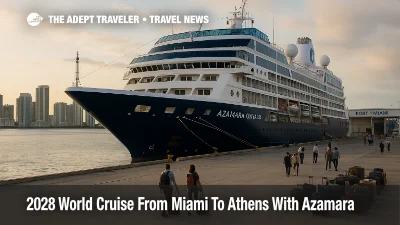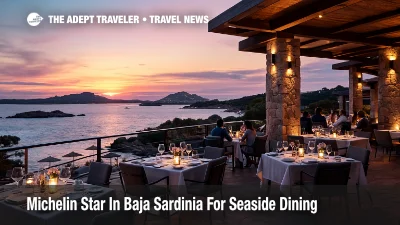Tuscany, Italy

If you are seeking an idyllic escape filled with unforgettable experiences, it's time to travel to Tuscany, Italy, a destination that seamlessly combines historical charm, natural beauty, and cultural richness. Travel to Tuscany and discover a region where rolling hills dotted with vineyards and olive groves invite visitors to relax and indulge in the exquisite local wine and cuisine. Tuscany's captivating landscapes, from the iconic cypress-lined roads of Val d'Orcia to the enchanting coastal town of Viareggio, offer diverse scenery for every traveler. The medieval cities of Siena, with its stunning Gothic architecture, and Florence, the cradle of the Renaissance, are treasure troves of art, history, and vibrant local life. Whether you are wandering through the narrow alleyways of centuries-old towns or exploring the artistic masterpieces housed in the Uffizi Gallery, Tuscany promises an immersive cultural journey. Don't miss the opportunity to experience the picturesque countryside, where rustic farmhouses and luxury villas provide perfect havens for relaxation. Adventure enthusiasts will find plenty of opportunities for hiking, cycling, and even hot air ballooning over the lush landscapes. Tuscany, Italy, is more than just a destination; it's an invitation to embrace la dolce vita, surrounded by stunning vistas and steeped in rich heritage. So, pack your bags and travel to Tuscany, where every moment is a delightful mix of elegance, tranquility, and awe-inspiring beauty.
The History of Tuscany, Italy
Travel to Tuscany, Italy, and embark on a journey through time, exploring a region where history breathes through its cobbled streets and ancient towns. Tuscany, renowned for its picturesque landscapes and rich cultural heritage, offers an immersive experience into the milestones of Western civilization. From its Etruscan origins to its modern-day vibrancy, the history of Tuscany unfolds like a captivating story, drawing travelers from all corners of the globe to witness its timeless charm.
When you travel to Tuscany, Italy, you're stepping into a land that was once the cradle of the Etruscan civilization long before the rise of Rome. The Etruscans, who flourished between the 8th and 3rd centuries BC, left behind a wealth of archeological treasures and ruins that provide a vivid insight into their sophisticated society. Ancient cities such as Volterra and Fiesole showcase remarkable artifacts, including intricate tombs and pottery that reflect the Etruscans' advanced artistry and cultural achievements. A visit to these sites is not merely a step back in history but a unique chance to understand the origins of one of Italy's earliest civilizations.
Tuscany, Italy, is also synonymous with the Renaissance, an era that saw an explosion of artistic and intellectual energy. As the birthplace of the Renaissance, Tuscany's cities like Florence became the canvas for visionaries such as Leonardo da Vinci, Michelangelo, and Dante Alighieri. Traveling through Florence, you can admire the towering Duomo, marvel at the masterpieces in the Uffizi Gallery, or stand in awe of Michelangelo’s David. Each corner of the city echoes with the footsteps of geniuses who redefined art, literature, and science. Travel to Tuscany to witness firsthand the legacy of this transformative period in human history, where every museum, gallery, and palace tells a story of creativity and profound innovation.
As you continue your travel to Tuscany, Italy, you will discover medieval treasures in cities like Siena and Pisa. The historic center of Siena, with its magnificent Gothic architecture and the iconic Piazza del Campo, allows you to explore a meticulously preserved medieval town that still hosts the thrilling Palio horse race. Meanwhile, Pisa's Leaning Tower and the nearby cathedral and baptistery are testament to the region's architectural prowess and historical wealth. These landmarks encapsulate the medieval spirit that pervaded Tuscany, offering travelers a vivid glimpse into the past.
Making the decision to travel to Tuscany is more than just a vacation; it's a voyage into the heart of European history. The region's layered past, from ancient Etruscan settlements to Renaissance splendor and medieval grandeur, provides a compelling narrative that resonates deeply with anyone interested in the heritage of civilization. Whether strolling through Florence’s art-filled streets, discovering ancient relics in Volterra, or marveling at the medieval wonders of Siena and Pisa, Tuscany, Italy, promises an unparalleled historical adventure that enriches the soul and ignites the imagination.
The Culture of Tuscany, Italy
The allure of Tuscany, Italy, is undeniable. The region is a cultural tapestry woven with the threads of Renaissance art, rich history, and illustrious traditions. When you travel to Tuscany, you embark on more than just a vacation; you immerse yourself in a living museum where the landscape and local customs narrate tales of a bygone era and vibrant modernity. The local people, known for their warmth and hospitality, open their doors and hearts to visitors, making any travel to Tuscany an unforgettable experience.
Renaissance Art and Architecture
Tuscany is the cradle of the Renaissance, and its cities are adorned with architectural marvels and art treasures that date back centuries. Wander through Florence, the capital of Tuscany, Italy, and you'll encounter masterpieces by artists like Michelangelo, Leonardo da Vinci, and Botticelli. The Uffizi Gallery and the Cathedral of Santa Maria del Fiore are just a few examples of the magnificent art that awaits you. The local residents take immense pride in their heritage, often sharing stories and insights into the artistic splendors that pepper the region. Whether you are an art enthusiast or a casual traveler, the experience is both enlightening and inspiring.
Culinary Delights
Travel to Tuscany, and your taste buds will thank you. The region is synonymous with exceptional cuisine and world-class wines. Picture yourself indulging in a sumptuous bowl of homemade pasta while sipping on a glass of Chianti Classico, all while seated in a charming trattoria overlooking rolling vineyards. The people of Tuscany, Italy, are intensely passionate about their culinary traditions, and they take pride in using fresh, local ingredients. From the iconic bistecca alla fiorentina (Florentine steak) to delectable pastries, each dish tells a story of its own. Cooking classes, vineyard tours, and farm-to-table dining experiences are easily accessible, providing an authentic taste of Tuscan life.
Festivals and Traditions
Local festivals and traditions are at the heart of Tuscan culture. Throughout the year, the towns and villages of Tuscany, Italy, come alive with colorful celebrations that spotlight their historical and cultural heritage. Events like the Palio di Siena, a thrilling horse race held in Siena’s Piazza del Campo, and the Calcio Storico, a historic football match in Florence, exemplify the region’s communal pride and joy. The people of Tuscany welcome travelers to join in these festivities, offering a genuine opportunity to witness and participate in centuries-old traditions. Such experiences transform your travel to Tuscany into a memorable cultural odyssey, leaving you with stories to tell for years to come.
When you travel to Tuscany, you become part of a vibrant culture that seamlessly blends the past with the present. The people of Tuscany, Italy, with their rich traditions and warm hospitality, ensure that every visitor feels like a part of the Tuscan tapestry. From the breathtaking Renaissance art and architecture to the delectable culinary adventures and spirited festivals, Tuscany offers a multifaceted cultural experience that beckons travelers from around the world. If you seek a destination that promises both relaxation and enrichment, travel to Tuscany, and discover the captivating charm and enduring legacy of this remarkable region.
The Food of Tuscany, Italy
Tuscany, Italy, offers a spectacular culinary experience that tantalizes the taste buds and captures the essence of Italian cuisine. As travelers embark on their journey through Tuscany, they will quickly discover that this region is a paradise for food lovers. From the rich flavors of fresh, hand-made pasta to the robust aromas of locally produced wines, every meal in Tuscany becomes a memorable adventure. Travelers will find themselves indulging in dishes that highlight the freshest seasonal ingredients, often sourced from local farms and markets. Each bite tells a story of tradition, craftsmanship, and passion for food.
The Richness of Tuscan Cuisine
Travel to Tuscany and you'll find that the culinary traditions here are deeply rooted in the region's rich agricultural heritage. The local fare often features simple, rustic dishes that allow the high quality of ingredients to shine. Consider starting your day with a traditional breakfast of fresh bread, locally-made jam, and a robust espresso. As you explore the region, you will come across family-run trattorias where chefs prepare classic dishes such as ribollita, a hearty bread soup made with vegetables and beans, or pappardelle al cinghiale, wide pasta ribbons served with succulent wild boar ragu. These hearty meals, paired with local Chianti wine, offer a truly authentic taste of Tuscany, Italy.
Exquisite Wines and Olive Oils
One of the highlights of a culinary adventure in Tuscany is tasting the world-renowned wines and olive oils. When you travel to Tuscany, Italy, make sure to visit the numerous vineyards and olive groves that dot the landscape. Here, you can partake in guided tours and tastings that provide an in-depth look at the production process. Savor the vibrant flavors of Chianti, Brunello di Montalcino, and Vino Nobile di Montepulciano, each with its unique characteristics and history. The extra virgin olive oil produced in Tuscany is equally exceptional, known for its robust, peppery flavor, and vibrant green color. Bringing home a bottle of Tuscan olive oil or wine is like capturing a piece of this beautiful region to savor later.
Farm-to-Table Experiences
For those who wish to dive deeper into the culinary scene, Tuscany offers unparalleled farm-to-table experiences. When you travel to Tuscany, Italy, take the opportunity to visit organic farms and agriturismos (farm stays) where you can see, first-hand, how the ingredients go from farm to table. Many agriturismos offer cooking classes where you can learn to prepare traditional Tuscan dishes using fresh, organic produce you’ve picked yourself. Enjoy a meal under the Tuscan sun, surrounded by the rolling hills and vineyards that characterize this stunning region. These farm-to-table experiences not only enhance your appreciation of the food but also connect you to the land and the people who cultivate it.
Travel to Tuscany is more than just a trip; it’s an immersive culinary journey that leaves a lasting impression. The combination of high-quality ingredients, traditional recipes, and the sheer passion of Tuscan chefs ensures a dining experience that is both unique and unforgettable. Whether you're savoring a simple yet delectable plate of classic spaghetti alle vongole or enjoying a full-course meal at a Michelin-starred restaurant, Tuscany, Italy, is sure to captivate your palate and enrich your travel memories.
What to See and Do in Tuscany, Italy
When you travel to Tuscany, Italy, you will find yourself immersed in a landscape rich with history, culture, and exquisite cuisine. To fully appreciate the wonders of Tuscany, here are ten must-do activities, each brimming with detailed experiences that will make your trip memorable.
Explore Florence
Florence, Italy, is the heart of Tuscany and the cradle of the Renaissance. It's a treasure trove of art and architecture waiting to be discovered. Begin your tour at the iconic Florence Cathedral, known as the Duomo, and admire its striking façade and Brunelleschi's Dome. Step inside the Uffizi Gallery to marvel at masterpieces by Michelangelo, Botticelli, and Raphael. Wander across the historic Ponte Vecchio bridge, lined with glittering jewelry shops, and don’t miss the grandeur of Palazzo Vecchio, which holds a rich history dating back to the 14th century.
Wine Tasting in Chianti
When you travel to Tuscany, Italy, a visit to the Chianti region is essential for wine enthusiasts. Nestled between Florence and Siena, this picturesque area is renowned for its vineyards. Book a wine tasting tour in the Chianti Classico area to sample some of Italy’s finest wines, including the famous Chianti Classico DOCG. Many estates also offer tours of their wine cellars and vineyards, providing a behind-the-scenes look at the winemaking process. Pair your wine tasting with local delicacies like pecorino cheese, olive oil, and cured meats.
Siena’s Piazza del Campo
Siena, Italy, is home to one of the most beautiful medieval squares in Europe, Piazza del Campo. This shell-shaped piazza is the heart of the city and the site of the famous Palio horse race, held twice a year. Climb the Torre del Mangia for stunning views of the city and the surrounding Tuscan countryside. Explore the intricate marble floors and stunning frescoes of the Siena Cathedral, and stroll through the historic streets to soak in the city’s unique atmosphere.
Relax at the Thermal Baths in Saturnia
Located in the Maremma area of Tuscany, Italy, the thermal baths in Saturnia offer a rejuvenating experience. These natural hot springs, known as Cascate del Mulino, feature cascading limestone pools filled with mineral-rich waters. Enjoy a therapeutic soak while surrounded by the serene Tuscan countryside. Many visitors also indulge in spa treatments and massages at nearby wellness resorts, making it a perfect spot for relaxation.
Discover the Tower of Pisa
Your travel to Tuscany would be incomplete without a visit to Pisa, Italy, and its world-famous Leaning Tower. This freestanding bell tower, part of the cathedral of the city, has captivated visitors with its unintended tilt for centuries. Climb the tower for panoramic views of Pisa and explore the adjacent cathedral and baptistery, which together form the exquisite Piazza dei Miracoli. The site offers a fascinating blend of architectural prowess and historical intrigue.
Tour the Val d'Orcia
The Val d'Orcia, a UNESCO World Heritage site, is quintessential Tuscany, Italy. This region south of Siena is famed for its rolling hills, cypress-lined roads, and picturesque villages. Visit the medieval town of Pienza, known as the “ideal city” of the Renaissance, and savor its renowned pecorino cheese. Wander through the vineyards and olive groves of Montalcino and sample Brunello di Montalcino, one of Italy’s most prestigious wines. The landscape of Val d'Orcia is perfect for scenic drives, hikes, and photography.
Cooking Classes in Lucca
Lucca, Italy, offers a delightful way to immerse yourself in Tuscan cuisine through cooking classes. Join a local chef in preparing traditional dishes like fresh pasta, ribollita (a hearty vegetable stew), and cantucci (almond biscuits). Many classes also include a visit to local markets to select fresh ingredients, providing a comprehensive culinary experience. These classes not only highlight Tuscan recipes but also impart cooking techniques that you can bring home and share with loved ones.
Visit San Gimignano’s Towers
Known as the “Manhattan of the Middle Ages,” San Gimignano, Italy, is renowned for its medieval towers. Although only 14 of the original 72 towers remain, they create a striking silhouette against the Tuscan sky. Wander through the charming streets, visit the Collegiata di Santa Maria Assunta with its beautiful frescoes, and climb the Torre Grossa for a breathtaking view of the surrounding countryside. San Gimignano is also famous for its Vernaccia wine, which you can taste at local wineries.
Explore the Art of Arezzo
Arezzo, Italy, is a lesser-known gem in Tuscany with a rich history and vibrant art scene. Begin your visit at the Basilica of San Francesco to see Piero della Francesca’s masterpiece, “The Legend of the True Cross.” The city’s historic center features beautiful squares like Piazza Grande, known for its jousting tournaments and antique market. Arezzo's annual medieval festival, the Giostra del Saracino, is a lively event that showcases the city’s cultural heritage.
Hiking in the Apuan Alps
For travelers who love outdoor adventures, the Apuan Alps in Tuscany, Italy, offer stunning hiking opportunities. These mountains are characterized by dramatic peaks, marble quarries, and lush forests. The region provides a variety of trails for different skill levels, ranging from gentle walks to challenging climbs. Popular routes include the ascent to Monte Forato, with its natural rock arch, and Monte Pisanino, the highest peak in the range. The Apuan Alps are also home to charming villages and delectable local cuisine.
Each of these experiences contributes to the rich tapestry of travel to Tuscany, Italy. Whether you're passionate about art, history, wine, or outdoor adventures, Tuscany offers a myriad of unforgettable activities that will leave you longing for another visit.
Why You Should Travel to Tuscany, Italy
Tuscany, Italy is a destination that seems to encapsulate the very essence of everything you could ever dream about when thinking of the perfect European getaway. This region has long been heralded as a sanctuary for those seeking to travel and uncover the unparalleled charm. The hillsides painted in hues of green, adorned with cypress trees and bordered by vineyards, create an idyllic scenery that feels almost dreamlike. Historical cities like Florence and Siena are enriched with Renaissance art, captivating architecture, and culturally significant landmarks. These cities provide travelers with a well-rounded experience that transcends mere sightseeing, offering an immersive dive into the soul of Tuscany.
Delectable Cuisine and Fine Wines
The culinary scene is another compelling reason why many choose to travel to Tuscany, Italy. The local cuisine is deeply rooted in tradition, emphasizing simplicity and freshness. Dishes made from local ingredients like pecorino cheese, truffles, and bistecca alla fiorentina (Florentine steak) are bound to leave your taste buds in a state of euphoria. Pair these with Tuscany’s world-renowned wines, such as Chianti, Brunello di Montalcino, and Vino Nobile di Montepulciano, and you have a gourmet experience that is second to none. Food and wine tours are commonplace, providing travelers not just with the chance to savor these delights but to understand their origins and the expertise involved in their creation.
Rich Cultural Fabric
Beyond its scenic beauty and gourmet offerings, Tuscany is a tapestry of rich cultural heritage. From ancient Etruscan ruins to contemporary art galleries, the region is a mosaic of historical eras coexisting harmoniously. The medieval hilltowns like San Gimignano offer enchanting cobblestone streets and towers that dominate the skyline, telling stories of a time long past. The thermal baths and wellness retreats scattered across the countryside ensure that travelers looking for relaxation and rejuvenation will not be disappointed. Cultural festivals, such as the Palio di Siena, bring the traditions and history of Tuscany, Italy to vivid life, ensuring that your travels here are filled with memorable experiences.
Why You Must Travel to Tuscany, Italy
Your decision to travel to Tuscany, Italy is hardly just about ticking a destination off your bucket list; it is about immersing yourself in a multi-sensory experience that engages your mind, body, and soul. This enchanting region offers a unique blend of natural beauty, exquisite flavors, and rich cultural history that is hard to find elsewhere. Whether you are looking to explore art and history, indulge in fine wines and delectable cuisine, or simply unwind amidst breathtaking landscapes, Tuscany promises an unforgettable journey. The allure of Tuscany lies in its ability to offer something for every kind of traveler, ensuring that your trip will be nothing short of magical.
Tips & Tricks for Traveling in Tuscany, Italy
Travel to Tuscany, Italy is a dream for many, promising landscapes straight out of a Renaissance painting and cultural experiences aplenty. To ensure you get the most out of your journey, we've compiled ten tips and tricks that will make your travel to Tuscany smooth, enriching, and unforgettable.
1. Plan Around Local Festivals
One of the best ways to immerse yourself in the local culture when you travel to Tuscany is to time your visit around local festivals. Events like the Palio di Siena, the Lucca Summer Festival, and Florence's Scoppio del Carro offer unique insights into Tuscan traditions and provide unforgettable experiences.
2. Explore the Countryside by Car
The picturesque landscapes of Tuscany, Italy are best enjoyed by renting a car and driving through the rolling hills and vineyard-lined roads. This gives you the flexibility to explore quaint villages like San Gimignano and Montepulciano at your own pace, discovering hidden gems off the beaten path.
3. Use Public Transport in Cities
While a car is ideal for the countryside, cities in Tuscany like Florence, Pisa, and Siena have well-developed public transport systems. Buses and trains are cost-effective and convenient, allowing you to avoid the hassle of parking in crowded city centers.
4. Stay in Agriturismi
Agriturismi, or farm stays, offer a fantastic way to experience the Tuscan lifestyle. Staying at an agriturismo not only provides comfortable accommodations but also gives you a taste of local agriculture, from olive oil production to wine tasting.
5. Savor Tuscan Cuisine
No travel to Tuscany is complete without indulging in its rich culinary heritage. From savoring a bowl of ribollita (hearty vegetable soup) to enjoying bistecca alla Fiorentina (Florentine steak), make sure to frequent local trattorias and osterias to savor authentic Tuscan flavors.
6. Visit Lesser-Known Towns
While Florence and Siena are must-see destinations, don't skip the lesser-known towns in Tuscany, Italy. Places like Pienza, Cortona, and Volterra offer equally stunning architecture and fewer tourists, allowing for a more relaxed experience.
7. Book Museums and Attractions in Advance
Popular attractions like the Uffizi Gallery in Florence and the Leaning Tower of Pisa can get crowded, especially during peak travel seasons. Booking tickets in advance not only secures your entry but also helps you avoid long lines, giving you more time to explore.
8. Take a Wine Tour
Tuscany is renowned for its wine, and taking a wine tour is an excellent way to explore this aspect of the region. Whether you're in the Chianti region or Montalcino, guided tours offer insights into the winemaking process and include tastings of some of the best wines Tuscany, Italy has to offer.
9. Learn Basic Italian Phrases
While many locals in Tuscany speak English, learning a few basic Italian phrases can go a long way. Simple greetings, thank-yous, and questions can enhance your interactions and make your travel to Tuscany more enjoyable. Plus, locals always appreciate the effort.
10. Be Prepared for Variable Weather
The weather in Tuscany, Italy can be quite variable, ranging from hot summers to rainy springs and autumns. Pack accordingly, with layers that you can adjust based on the day's weather. Remember to also pack comfortable walking shoes, as exploring Tuscan towns often involves a lot of walking.
By following these tips, your travel to Tuscany, Italy will be enriched with authentic experiences, stunning landscapes, and memorable adventures. Whether you're sipping wine in a vineyard or getting lost in a medieval town, Tuscany has something to offer everyone.
Other Places You Might Like
Provence, France – If you love Tuscany, you'll adore Provence, France. This picturesque region offers similar pastoral landscapes filled with lavender fields, olive groves, and vineyards. While traveling here, you can explore charming medieval villages like Gordes and Roussillon, or relax in the vibrant markets of Aix-en-Provence. Renowned for its cuisine, Provence also offers a delight for the palate with dishes like ratatouille and bouillabaisse. Consider a hot air balloon ride over the Luberon Valley to experience the breathtaking scenery from above – an unforgettable travel memory to add to your collection.
Andalusia, Spain – Those who have fond memories of traveling to Tuscany will find much to love in Andalusia, Spain. This sun-drenched region is known for its dramatic landscapes, including the rolling hills of olive trees and the rugged Sierra Nevada mountains. Cities like Seville, Granada, and Córdoba are cultural treasures, with their Islamic architecture and flamenco traditions. The vibrant street life, delectable tapas, and striking Alhambra Palace make Andalusia a travel destination that promises to enchant and inspire just like Tuscany, Italy.
Douro Valley, Portugal – For those who travel to Tuscany for its vineyards and rolling hills, the Douro Valley in Portugal offers a familiar yet unique experience. The region is renowned for its terraced vineyards producing port wine, making it a paradise for wine enthusiasts. The Douro River winds through the lush landscape, with quintas (wine estates) dotting the hillsides. Take a scenic cruise along the river or a train through the valley to soak in the breathtaking views. The Douro Valley’s blend of natural beauty and wine culture is sure to captivate anyone who loves Tuscany, Italy.
Bavaria, Germany – Travel to Bavaria and discover a region that, while distinct from Tuscany, offers an equally charming rural appeal. This southern German state is famous for its picturesque countryside, dotted with fairytale castles like Neuschwanstein and Hohenschwangau. The lush meadows, alpine landscapes, and historic villages such as Rothenburg ob der Tauber provide a scenic retreat reminiscent of Tuscany's gentle hills and ancient towns. Bavaria's hearty cuisine, with dishes like schnitzel and pretzels, paired with the region's famed beers, ensures a delightful culinary experience.
Cotswolds, England – Fans of Tuscany's idyllic countryside will feel right at home in the Cotswolds, England. This area of outstanding natural beauty is renowned for its rolling hills, charming stone cottages, and historic market towns such as Chipping Campden and Bourton-on-the-Water. The Cotswolds offer wonderful walking trails, where you can wander through lush meadows and along tranquil rivers. Visiting cozy pubs and enjoying a traditional cream tea will add to your delight. The timeless charm and rural serenity here mirror the tranquil beauty found while traveling to Tuscany, Italy.
Ticino, Switzerland – If you love the combination of lush landscapes and rich cultural heritage found in Tuscany, Switzerland’s Ticino region will captivate you. Located in the southern part of Switzerland, this region feels distinctly Mediterranean with its palm trees, lakes, and charming villages. The blend of Italian and Swiss cultures is evident in the local cuisine and architecture. Explore the stunning shores of Lake Lugano, enjoy the medieval castles in Bellinzona, or visit the colorful towns of Ascona and Locarno. Ticino's scenic beauty and cultural richness make it a must-visit destination for Tuscany enthusiasts.
Italy Air Transport Strike Disrupts Flights Dec 17, 2025

Schengen Internal Border Checks Widespread In Late 2025

Europe Air Traffic Control Delays Worsen, Add Buffers

Italy General Strike Hits Trains, Airport Links Dec 12, 2025

Europe December Strikes Hit Holiday Flights And Trains

Italy December 12 Strike Hits Trains And Airport Links

New Amsterdam Milan Night Train Opens Alpine Option

Maltese Falcon Med Caribbean Cruises December 2025

Italy December Strikes Threaten Rome Transit And Rail

Milan Key Box Ban From 2026 For Short Term Rentals

Europe 2025 Travel Rules Tighten Borders And Costs

Houston Rome Nonstop Flights Start May 2026

Snow To Cause Nordic And Alpine Airport Delays

Italy General Strike December 12 To Disrupt Travel

2028 World Cruise From Miami To Athens With Azamara

New Melbourne Doha Flights Expand Europe Options

Italy December 2025 Transport Strikes Hit Travel

France December 2 Strike Spares Most Trains And Metro

2027 Mediterranean Season Adds Egypt Yacht Voyages

Michelin Star In Baja Sardinia For Seaside Dining

Italy General Strike November 28 Cuts Trains And Flights

Italy General Strikes Hit Flights And Trains Nov 28, Dec 12

December Strikes Hit Europe, New Zealand Flights, Trains

Europe Rail Pass Sale Offers 25 Percent Off Global Passes

European Airport Delays At Major Hubs November 23-24

